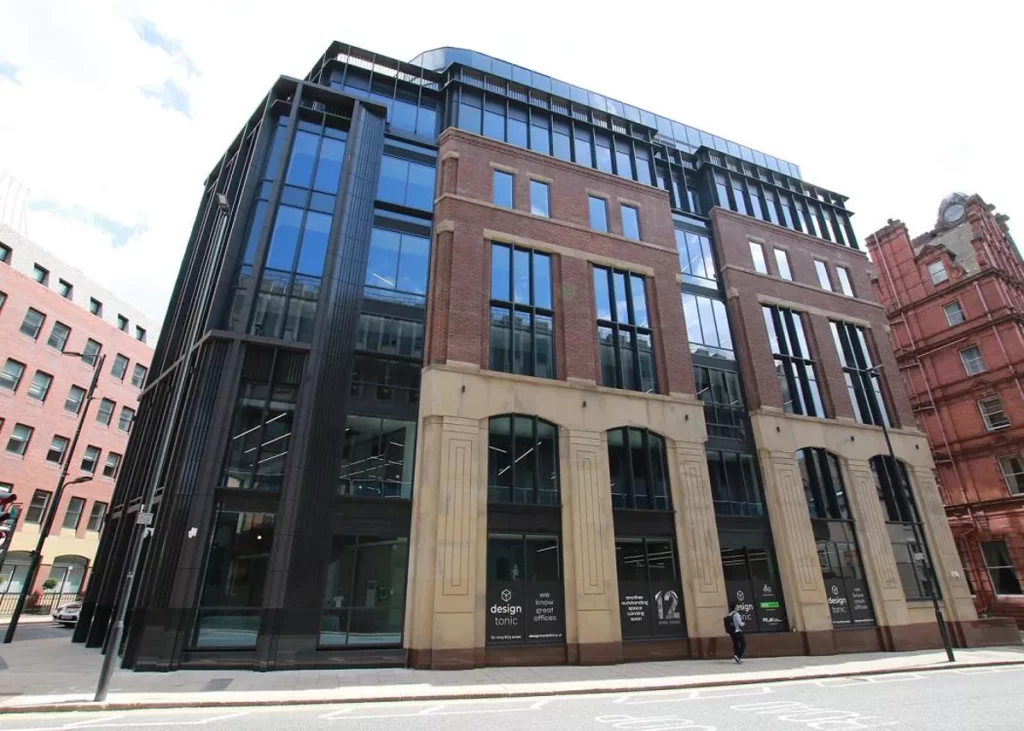Having refurbished the 12 King Street facility in Leeds, its owners Fiera Real Estate (FRE) and Opus North have addressed a number of the current areas of discussion surrounding the adoption and application of modern construction techniques.
Carbon footprint is now a major consideration for all construction projects and refurbishment is considered to create far fewer emissions than demolition and the building of a new facility, depending on the type and condition of the existing fabric. In the case of 12 King Street, it has been transformed into a BREEAM Excellent building, which means not only has its refurbishment been less carbon intensive than a rebuild, but its carbon emissions will be 14% less in future.
These efforts have had further beneficial effects, including a 29% reduction in energy consumption – which has taken on additional importance following the recent rise in utility prices. The building’s refurbishment has also reduced its water consumption by 42%, which will deliver further reductions in cost for the owners and tenants.
Perhaps the most important aspect of its redevelopment is that it can now clearly be described as a smart building. While the term ‘smart’ has been applied by some to describe mundane or basic use of technology, 12 King Street is at the cutting edge and makes use of the latest applications.
Yet another aspect of topical importance is that of how to apply technology and, for the building owners, this was a central element within the very first considerations for the project. Further explanation of the project is provided by Equans Smart Buildings director Mark Davenport. He says: “The building was renovated from top to bottom and refurbished entirely. The Equans SMARTR system was designed in as an integral part of the refurbishment programme and installed as the work proceeded.”
This means that the core infrastructure was installed as an integral part from phase one of the project and continued into the fit out, with each new tenant adopting the smart options.
“The core infrastructure and integration functionality are included in the landlord’s services and the cost is incorporated into the rent,” he continues. “In addition, tenants are able to choose from a wide selection of soft services, such as room booking, visitor management, etc.
“Several tenants have chosen to replace their existing programs with smart services as this often proves more cost-effective. Typically, the tenant will end up with a mix of smart services and their own platforms for a range of functions. This option has proved effective in attracting new tenants.”
All the modules are Software as a Service (SaaS) applications and are available for tenants to either buy outright or rent. The data uses the AWS Cloud service and can also feed into other cloud services, as well as any on-site options.
Users are provided with full dashboard functionality for monitoring and analysis, with alerts generated for data falling outside set parameters. Mr Davenport provides the diagram below to illustrate the stages of enabling and implementing smart building technology.

Further insight to the complete transformation of the building can be obtained by the fact that, prior to the project, it was operated through the use of basic applications such as timers and thermostats.
Those using the platform are now able to obtain data about any aspect of each system within the building, along with analysis of air quality and various additional elements relating to the health and safety of users.
Mr Davenport explains that while his company owns the SMARTR Multisense platform, the data it provides is owned by the landlord or tenant who purchases the applications. Those renting the applications are provided with all the necessary support services from Equans, which is the legal owner in these instances.
“Regardless of whether these are purchased or rented, the platform provides unique integration between the various functions and protocols in the building and the apps are designed to be highly intuitive. Equans additionally provides tuition if required to make sure end users get the most out of the system,” Mr Davenport continues.
The platform uses the building’s lighting system to gather all the data from the facility. He adds: “The ubiquity of lighting throughout the building makes it the ideal ‘backbone’ of the system, carrying the sensors that gather a wide range of data – way beyond the data required for lighting control. This data is then fed back to the system, which acts as the ‘brains’ of the platform, communicating with all the other elements through category 6 cabling.”

“This is an end-to-end platform that incorporates hardware and software applications along with wired and wireless technologies – utilising standard integration applications such as API, SDK, MQTT etc. A key strength of the SMARTR Multisense network is that it has the ability to normalise all of the different protocols used by the various manufacturers and enables them to communicate with each other.
“This is the key to a smart building as traditional building control designs are unable to achieve this level of integration, so many systems tend to operate in silos. Because of the smart infrastructure, data can be collected from both wired and wireless networks.”
Having gathered in-depth information, this data is then used to control and support all the connected services and enable cross-functionality. For example, the Smart EnOcean protocol enables wireless and battery-less technology to feed data from the smart sensors on factors such as air quality, PIR, temperature, humidity, window status, door status, etc.
The network then distributes all the sensing data back out to the relevant systems to efficiently manage the building services. The system uses Bluetooth to communicate with users on their own devices.
This high level of integration enables those using the platform to adopt their preferred technologies to suit their specific needs and priorities. For instance, a tenant using a mix of their own and SMARTR applications can still share data between these.
The sensors can provide data over any of the communication protocols in use and utilise this to drive a detailed understanding of the building’s operational status. For example, the Bluetooth service can triangulate the location of an individual’s smart device to offer location-based services/wayfinding and life safety information.
Mr Davenport says the system is easily capable of supporting the wellbeing of occupants by recording and analysing information on a constant basis. “The system continually gathers and analyses a wide range of health-related environmental parameters (eg temperature, humidity, indoor air quality) and detects if any of these fall outside acceptable ranges – alerting building managers where appropriate. In this way, a healthy work environment is maintained and any issues pertaining to health or the immediate environment can be detected, and reacted to, promptly.”.
“In parallel, the system provides FM teams with comprehensive information about factors such as occupancy in workspaces and footfall in corridors, etcetera, to underpin efficient management of the building. This has a beneficial effect on the workforce’s experience and, therefore, their wellbeing,” he continues.
“This prioritisation of wellbeing is also an important factor in staff retention by tenants at a time when there are critical staff shortages in certain areas.”
He further explains that the platform has been developed to ensure that its integration and connectivity is future proof.
“Within the hardware, Equans can plug additional cards into the SMARTR Multisense platform on top of the options we have available today, to enable any future wired or wireless technologies that emerge. All the firmware updates to the network and devices can be applied wirelessly, so there is no requirement to go to each device when a new module has been added,” he says.
The company worked directly with the investment and development team on the 12 King Street project to scope and specify exactly how the infrastructure would be deployed. This is because specifying a smart building differs radically from traditional construction specification.
“We had to, effectively, break the norms of specification,” Mr Davenport explains. “In a traditional construction programme, the main contractor delegates the control aspects to the M&E contractor, so that control and monitoring effectively become separate aspects of the project. With a smart building, control, monitoring and data analysis are all integral to the building rather than separate entities and this needs to be reflected from the very outset of the project.
“Therefore, we created a high-level design primarily for the construction team to quote against. This enabled them to go out to tender with various manufacturers and know what data sets they needed. We then created a low-level specification to reflect how the project would be delivered. The building was enabled as a core,” says Mr Davenport.
The transformation of 12 King Street from its former state to being one of the smartest buildings in the UK is now complete and the owners and tenants are set to enjoy the benefits for many years into the future.





